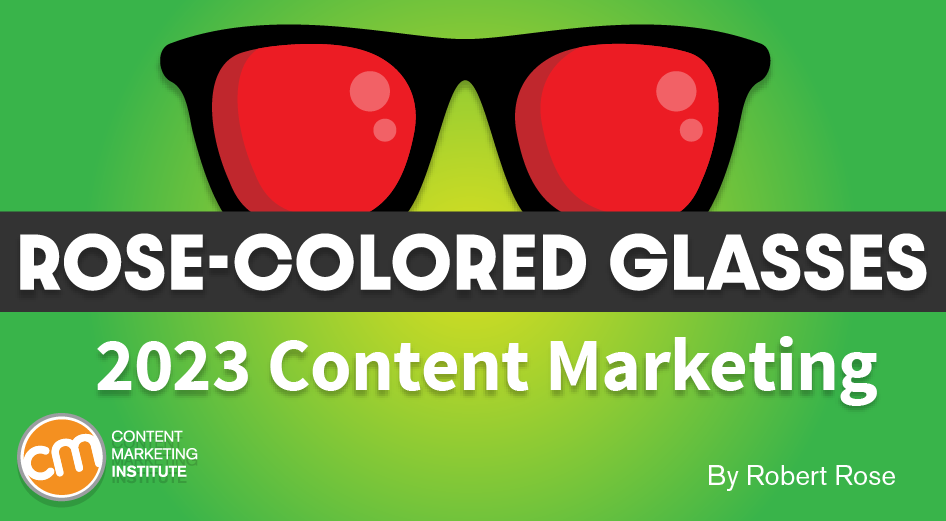MARKETING
State of Content Marketing in 2023

I just pressed send on the manuscript for my book to be released in September. It’s called Content Marketing Strategy (snappy, eh?), and Kogan Page will publish it.
Last week, marketing professor Philip Kotler wrote the foreword. I won’t spoil it, but he mentioned the need for a strategic approach to owned media.
He writes, “(T)he company doesn’t carry an account of showing these marketing assets and their value. As a result, the company cannot show the CEO and company board members a return on owned assets or content.”
Luckily, my upcoming book shows exactly how to do that. Funny how that works out.
In any event, all this struck me that now is an opportune time to look at where the beloved practice of content marketing stands today.
First, let’s go back to 1999 when Kotler published Kotler On Marketing, one of his more than 70 books. The latter 1990s – a time of tumultuous change – fueled most of the thinking for the book. But he knew that it was merely the beginning.
Kotler concluded the book with a section called “Transformational Marketing.” In the next decade, he wrote, “marketing will be re-engineered from A to Z. Marketing will need to rethink fundamentally the processes by which they identify, communicate, and deliver customer value.”
Well, it’s taken over two decades, but it’s finally happening.
Consumers have changed, but marketing operations are just starting to
In case you didn’t notice, almost every marketing conference these days starts with the same four or five requisite slides:
- Digital technologies, such as search and social media, empower consumers today.
- Consumers research, engage, buy, and stay loyal to brands in ways that have fundamentally changed.
- First-party data and privacy are of the utmost importance.
- Artificial intelligence begins to threaten the idea of the usefulness of search and pressure companies to deliver better and more personalized experiences.
You get it. Consumer expectations in the age of the social, mobile, and AI-driven web are different than they were.
However, the continuing challenge in 2023 is that content and/or marketing operations in enterprise companies are only beginning to evolve. Most marketing departments have remained as they were when Kotler wrote his book — they still work from mid- to late-20th century hierarchies, strategies, and processes.
Most marketing departments still work with mid- to late-20th-century hierarchies, strategies, and processes, says @Robert_Rose via @CMIContent. Click To Tweet
Content marketing isn’t new, but a content marketing strategy is
For hundreds of years, businesses have used content to affect some kind of profitable outcome. But the reality is this: Whether it was John Deere’s The Furrow from the 1800s, Michelin’s guide to car maintenance in the early 1900s, or even Hasbro’s GI-Joe partnership with Marvel in the 1980s, content was not — and is not for the most part now — a scalable, repeatable practice within the function of marketing. In short, companies almost always treat content marketing as a project, not a process.
That fundamental change will finally take hold in 2023. It could happen because of the digital disruption and ease by which you can now publish and distribute content to aggregate your own audiences. It could happen through the natural evolution that the ultimate outcome – more than the marketing – matters more.
As we roll through 2023 and beyond, content — and the exponentially increasing quantities of it produced by every organization — deeply affects not just your marketing strategy, but your business strategy. Content in marketing is now bigger than simply content marketing, and it should be dealt with as a component of that business strategy throughout the enterprise.
#Content in marketing is bigger than #ContentMarketing. Treat it as a component of the business strategy, says @Robert_Rose via @CMIContent. Click To Tweet
In 2023, the No. 1 focus of my consulting and advisory practice these days: help companies transform content into a repeatable, scalable, and measurable function that drives value through a multi-channel strategy. It’s bigger than publishing a blog, creating a lead-generating resource center, or sending an email newsletter. Today’s content marketing team is being absorbed into marketing because marketing and its various operations are fundamentally transforming into a content-producing machine.
It is not good enough to produce content “like a media company would.” The goal must be to operate as a media company does. Your job is not to change content to fit new marketing goals. Rather, your job in 2023 is to change marketing to fit the new business content goals.
Your job in 2023 is to change #marketing to fit the new business #content goals, says @Robert_Rose via @CMIContent. Click To Tweet
The unaware builds a case for the aware
The term “content marketing” continues to evolve. Even today, I run across those who still call it “brand publishing,” “custom content,” or “inbound marketing.”
My take matches with what Kotler described in 1999. I always thought the term “content marketing” would become part of “marketing” more broadly. In 2023, that happened. So, returning to the lexiconic debates of 2013, 2014, or 2015 doesn’t seem terribly productive. Content marketing is just good marketing, and marketing is just good content marketing.
That said, two kinds of companies do well at the broader view of content marketing. Some of them, such as Cleveland Clinic, Red Bull, Arrow Electronics, HubSpot, and REI, have purposely devised content marketing strategies as differentiating approaches to their marketing. They are succeeding.
Others, like Amazon, Microsoft, JPMorgan Chase, and Peloton, backed into a smart content marketing strategy. But executives at those companies probably don’t recognize it as such. If asked (and some have been), they would say acquiring or launching a media company operation was just a smart business strategy to diversify their ability to reach their consumers consistently.
They’re right, of course. Many have yet to read books about content marketing, been influenced by the Content Marketing Institute, or even recognize content marketing as a separate approach (as far as I know). And they are also succeeding.
Consider this proof: As I write this article, six companies have a market capitalization of more than $1 trillion. Four of the six wholly or partially use the business model of media creation to further marketing and business strategies. Apple, Microsoft, Alphabet, and Amazon are all, in part, media companies that also sell products and services.
Why would you not avail yourself of that same model?
The future looks cloudy and bright
As for the overall state of enterprise content marketing, it’s in transition, as all marketing is. As a focused project-based approach, working in ad-hoc ways across a business, content marketing appears to have proven its worth. Hundreds of entries every year to the Content Marketing Awards feature myriad case studies using content marketing techniques in strategic ways to profitably affect business results.
And yet, it remains to be seen whether you can make content marketing a scalable, repeatable, measurable function within marketing.
As to what the discipline’s future holds? At last year’s Content Marketing World, one of my favorite events, the Executive Forum gathered senior leaders from brands succeeding with content marketing. As we talked about the future, one participant said: “The only certainty is change. I can’t tell you where or when, but I do know there will be change, and this is the principle we build on now.”
As for my take, Kotler’s idea of transforming the marketing function seems to have gotten lost along the digital road traveled by marketers. In so many cases, marketing – and especially content – remains just an on-demand service function within the business. Its sole job is to produce ever more voluminous amounts of content that describe the value of the brand (or its products or services) so that sales can sell more efficiently, customer support can serve more effectively, and all manner of customer interfaces are more beneficial to both sides.
However, and maybe because I need to rationalize now that my book is finished, I passionately believe it’s finally time for marketing to reclaim its ability to create value — not just reflect it in the polished shine of your traditional products and services.
Almost 27 years ago today, Microsoft founder Bill Gates wrote an essay called Content is King. In it, he said that “(C)ontent is where I expect much of the real money will be made on the Internet, just as it was in broadcasting.”
It certainly was one of his more prescient moments. Nearly three decades later, his words have proven true. The essay title has become the rallying cry for thousands and thousands of entrepreneurs who now make their living on creating, managing, optimizing, and measuring content on the internet. (A Google search for “content is king” nets more than 1.7 million results.)
But it’s the last line of his essay that I find the most visionary: “(T)hose who succeed will propel the Internet forward as a marketplace of ideas, experiences, and products – a marketplace of content.”
That’s what content marketing is for me in 2023. It’s just marketing – optimizing the value of ideas, experiences, and products in a marketplace of content.
Time to get to work.
It’s your story. Tell it well.
Get Robert’s take on content marketing industry news in just five minutes:
Watch previous episodes or read the lightly edited transcripts.
HANDPICKED RELATED CONTENT:
Cover image by Joseph Kalinowski/Content Marketing Institute
MARKETING
How To Develop a Great Creative Brief and Get On-Target Content

Every editor knows what it feels like to sit exasperated in front of the computer, screaming internally, “It would have been easier if I’d done it myself.”
If your role involves commissioning and approving content, you know that sinking feeling: Ten seconds into reviewing a piece, it’s obvious the creator hasn’t understood (or never bothered to listen to) a damn thing you told them. As you go deeper, your fingertips switch gears from polite tapping to a digital Riverdance as your annoyance spews onto the keyboard. We’ve all been there. It’s why we drink. Or do yoga. Or practice voodoo.
In truth, even your best writer, designer, or audiovisual content creator can turn in a bad job. Maybe they had an off day. Perhaps they rushed to meet a deadline. Or maybe they just didn’t understand the brief.
The first two excuses go to the content creator’s professionalism. You’re allowed to get grumpy about that. But if your content creator didn’t understand the brief, then you, as the editor, are at least partly to blame.
Taking the time to create a thorough but concise brief is the single greatest investment you can make in your work efficiency and sanity. The contrast in emotions when a perfectly constructed piece of content lands in your inbox could not be starker. It’s like the sun has burst through the clouds, someone has released a dozen white doves, and that orchestra that follows you around has started playing the lovely bit from Madame Butterfly — all at once.
Here’s what a good brief does:
- It clearly and concisely sets out your expectations (so be specific).
- It focuses the content creator’s mind on the areas of most importance.
- It encourages the content creator to do a thorough job rather than an “it’ll-do” job.
- It results in more accurate and more effective content (content that hits the mark).
- It saves hours of unnecessary labor and stress in the editing process.
- It can make all the difference between profit and loss.
Arming content creators with a thorough brief gives them the best possible chance of at least creating something fit for purpose — even if it’s not quite how you would have done it. Give them too little information, and there’s almost no hope they’ll deliver what you need.
On the flip side, overloading your content creators with more information than they need can be counterproductive. I know a writer who was given a 65-page sales deck to read as background for a 500-word blog post. Do that, and you risk several things happening:
- It’s not worth the content creator’s time reading it, so they don’t.
- Even if they do read it, you risk them missing out on the key points.
- They’ll charge you a fortune because they’re losing money doing that amount of preparation.
- They’re never going to work with you again.
There’s a balance to strike.
There’s a balance to be struck.
Knowing how to give useful and concise briefs is something I’ve learned the hard way over 20 years as a journalist and editor. What follows is some of what I’ve found works well. Some of this might read like I’m teaching grandma to suck eggs, but I’m surprised how many of these points often get forgotten.
Who is the client?
Provide your content creator with a half- or one-page summary of the business:
- Who it is
- What it does
- Whom it services
- What its story is
- Details about any relevant products and services
Include the elevator pitch and other key messaging so your content creator understands how the company positions itself and what kind of language to weave into the piece.
Who is the audience?
Include a paragraph or two about the intended audience. If a company has more than one audience (for example, a recruitment company might have job candidates and recruiters), then be specific. Even a sentence will do, but don’t leave your content creator guessing. They need to know who the content is for.
What needs to be known?
This is the bit where you tell your content creator what you want them to create. Be sure to include three things:
- The purpose of the piece
- The angle to lead with
- The message the audience should leave with
I find it helps to provide links to relevant background information if you have it available, particularly if the information inspired or contributed to the content idea, rather than rely on content creators to find their own. It can be frustrating when their research doesn’t match or is inferior to your own.
How does the brand communicate?
Include any information the content creators need to ensure that they’re communicating in an authentic voice of the brand.
- Tone of voice: The easiest way to provide guidance on tone of voice is to provide one or two examples that demonstrate it well. It’s much easier for your content creators to mimic a specific example they’ve seen, read, or heard than it is to interpret vague terms like “formal,” “casual,” or “informative but friendly.”
- Style guide: Giving your content creator a style guide can save you a lot of tinkering. This is essential for visuals but also important for written content if you don’t want to spend a lot of time changing “%” to “percent” or uncapitalizing job titles. Summarize the key points or most common errors.
- Examples: Examples aren’t just good for tone of voice; they’re also handy for layout and design to demonstrate how you expect a piece of content to be submitted. This is especially handy if your template includes social media posts, meta descriptions, and so on.
All the elements in a documented brief
Here are nine basic things every single brief requires:
- Title: What are we calling this thing? (A working title is fine so that everyone knows how to refer to this project.)
- Client: Who is it for, and what do they do?
- Deadline: When is the final content due?
- The brief itself: What is the angle, the message, and the editorial purpose of the content? Include here who the audience is.
- Specifications: What is the word count, format, aspect ratio, or run time?
- Submission: How and where should the content be filed? To whom?
- Contact information: Who is the commissioning editor, the client (if appropriate), and the talent?
- Resources: What blogging template, style guide, key messaging, access to image libraries, and other elements are required to create and deliver the content?
- Fee: What is the agreed price/rate? Not everyone includes this in the brief, but it should be included if appropriate.
Depending on your business or the kind of content involved, you might have other important information to include here, too. Put it all in a template and make it the front page of your brief.
Prepare your briefs early
It’s entirely possible you’re reading this, screaming internally, “By the time I’ve done all that, I could have written the damn thing myself.”
But much of this information doesn’t change. Well in advance, you can document the background about a company, its audience, and how it speaks doesn’t change. You can pull all those resources into a one- or two-page document, add some high-quality previous examples, throw in the templates they’ll need, and bam! You’ve created a short, useful briefing package you can provide to any new content creator whenever it is needed. You can do this well ahead of time.
I expect these tips will save you a lot of internal screaming in the future. Not to mention drink, yoga, and voodoo.
This is an update of a January 2019 CCO article.
HANDPICKED RELATED CONTENT:
Cover image by Joseph Kalinowski/Content Marketing Institute
MARKETING
Quiet Quitting vs. Setting Healthy Boundaries: Where’s The Line?

MARKETING
Microsoft unveils a new small language model

Phi-3-Mini is the first in a family of small language models Microsoft plans to release over the coming weeks. Phi-3-Small and Phi-3-Medium are in the works. In contrast to large language models like OpenAI’s ChatGPT and Google’s Gemini, small language models are trained on much smaller datasets and are said to be much more affordable for users.
We are excited to introduce Phi-3, a family of open AI models developed by Microsoft. Phi-3 models are the most capable and cost-effective small language models (SLMs) available, outperforming models of the same size and next size up across a variety of language, reasoning, coding and math benchmarks.
What are they for? For one thing, the reduced size of this language model may make it suitable to run locally, for example as an app on a smartphone. Something the size of ChatGPT lives in the cloud and requires an internet connection for access.
While ChatGPT is said to have over a trillion parameters, Phi-3-Mini has only 3.8 billion. Sanjeev Bora, who works with genAI in the healthcare space, writes: “The number of parameters in a model usually dictates its size and complexity. Larger models with more parameters are generally more capable but come at the cost of increased computational requirements. The choice of size often depends on the specific problem being addressed.”
Phi-3-Mini was trained on a relatively small dataset of 3.3 trillion tokens — instances of human language expressed numerically. But that’s still a lot of tokens.
Why we care. While it is generally reported, and confirmed by Microsoft, that these SLMs will be much more affordable than the big LLMs, it’s hard to find exact details on the pricing. Nevertheless, taking the promise at face-value, one can imagine a democratization of genAI, making it available to very small businesses and sole proprietors.
We need to see what these models can do in practice, but it’s plausible that use cases like writing a marketing newsletter, coming up with email subject lines or drafting social media posts just don’t require the gigantic power of a LLM.
Dig deeper: How a non-profit farmers market is leveraging AI
-

 SEO7 days ago
SEO7 days agobrightonSEO Live Blog
-

 SEO5 days ago
SEO5 days agoGoogle March 2024 Core Update Officially Completed A Week Ago
-

 WORDPRESS6 days ago
WORDPRESS6 days ago9 Best WooCommerce Multi Vendor Plugins (Compared)
-
SEARCHENGINES6 days ago
Daily Search Forum Recap: April 25, 2024
-

 MARKETING4 days ago
MARKETING4 days agoNavigating the Video Marketing Maze: Short-Form vs. Long-Form
-
![The Current State of Google’s Search Generative Experience [What It Means for SEO in 2024] person typing on laptop with](https://articles.entireweb.com/wp-content/uploads/2024/04/The-Current-State-of-Googles-Search-Generative-Experience-What-It.webp-400x240.webp)
![The Current State of Google’s Search Generative Experience [What It Means for SEO in 2024] person typing on laptop with](https://articles.entireweb.com/wp-content/uploads/2024/04/The-Current-State-of-Googles-Search-Generative-Experience-What-It.webp-80x80.webp) MARKETING5 days ago
MARKETING5 days agoThe Current State of Google’s Search Generative Experience [What It Means for SEO in 2024]
-

 SEO6 days ago
SEO6 days agoGoogle Declares It The “Gemini Era” As Revenue Grows 15%
-

 SEARCHENGINES5 days ago
SEARCHENGINES5 days agoGoogle March 2024 Core Update Finished April 19, 2024
















You must be logged in to post a comment Login